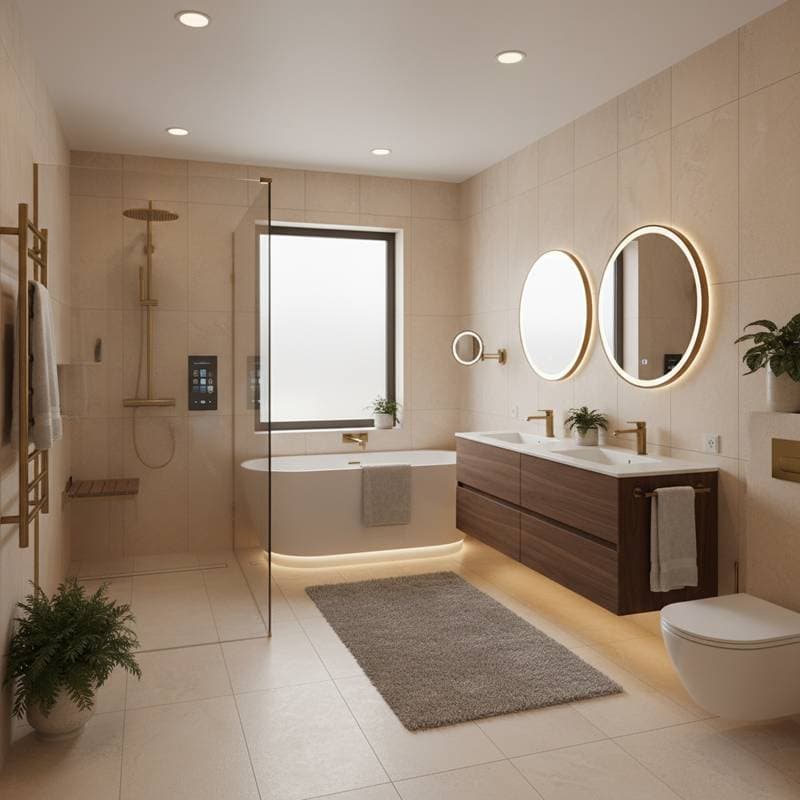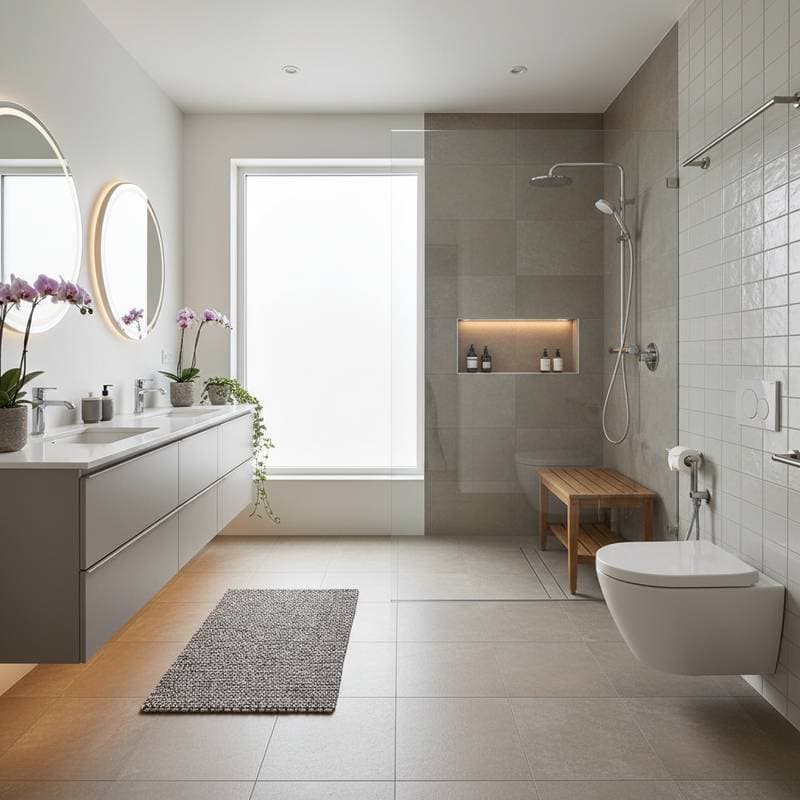Why Japandi Wet Rooms Will Define 2025 Bathrooms
Japandi wet rooms represent a transformative design movement in bathroom aesthetics. This style merges the clean simplicity of Scandinavian design with the serene minimalism of Japanese influences. The outcome is an open, calming, and restorative space that delivers a spa-like experience in both expansive homes and compact apartments.
The Essence of Japandi Design
Japandi emphasizes balance through the integration of Scandinavian warmth and Japanese restraint. Natural woods, soft neutral tones, and meticulous craftsmanship define the aesthetic. The approach prioritizes purposeful elements over excess, fostering a grounded and intentional environment.
In a bathroom context, this philosophy creates a sanctuary for relaxation. Surfaces, fixtures, and lighting choices enhance flow and tranquility. The style accommodates various budgets, from premium teak benches and artisanal ceramic tiles to thrifted stools, peel-and-stick stone tiles, and strategic accessories. Simplicity, functionality, and a connection to nature remain constant.
Why Wet Rooms Represent the Future
Wet rooms, long favored in luxury designs, now enter mainstream applications. By removing bulky shower enclosures, they expand visual space and convey luxury. Maintenance simplifies without glass doors or cluttered stalls, resulting in open, effortless areas.
Japandi wet rooms soften this openness with organic elements. Walls may feature microcement or stone-look porcelain finishes. Floors slope gently toward linear drains concealed under slim teak platforms. Fixtures in matte black, brushed brass, or soft white ensure seamless visual continuity, promoting deep breathing and unwinding.
Blending Functionality and Calm
Japandi wet rooms unite practical utility with nurturing ambiance. Materials resist moisture, endure daily use, and clean easily, yet avoid sterility. Budget-friendly laminates replicate natural textures at lower costs, maintaining aesthetic integrity.
Consider these design elements to embody the concept:
- Natural stone-look tiles in light gray or soft beige for floors and walls, providing timeless appeal.
- Built-in niches that integrate storage without disrupting wall continuity.
- Warm wood accents, such as floating vanities or bamboo stools, for tactile interest.
- Soft, diffused lighting to eliminate glare and foster peaceful illumination.
- Matte finishes on faucets, mirrors, and hardware to minimize visual distraction.
Details contribute subtly, embodying quiet elegance that distinguishes Japandi wet rooms.
Budget Options for Every Home
Japandi design adapts to diverse financial constraints, making serenity accessible. A premium renovation, including waterproof microcement walls, custom cabinetry, and designer fixtures, typically costs between $8,000 and $12,000. Comparable tranquility emerges at reduced expense through thoughtful selections.
Implement these cost-effective strategies:
- Opt for vinyl tiles mimicking stone, which install simply and deliver striking results.
- Select matte black or brushed bronze fixtures from affordable brands.
- Incorporate low-cost linear drain kits with a slight floor slope and waterproof membrane.
- Introduce bamboo mats or teak stools to infuse warmth and texture.
- Apply wall paint in shades resembling natural clay or limestone for earthy serenity.
Renters benefit similarly with peel-and-stick faux-stone backsplashes, neutral shower curtains, and minimalist accessories. These choices transform spaces into retreats regardless of budget or size.
Insights from Design Transformations
Design projects reveal that focused changes yield rapid, impactful results. Japandi wet rooms excel in this regard, enhancing perceived size and brightness through clean lines, reflective surfaces, and organic materials. The aesthetic translates effectively in various settings.
Lighting proves essential for success. In Japandi wet rooms, combine recessed lights, LED mirror strips, and accent fixtures for natural softness. Steer clear of harsh overhead illumination. Dimmable options, if feasible, allow transitions from invigorating morning settings to soothing evening moods.
Innovation Meets Serenity
Wet rooms encourage material advancements that balance beauty and utility. Waterproof lime plaster imparts velvety wall textures, while large-format porcelain panels minimize grout lines for seamless appearances. These choices endure, clean effortlessly, and elevate functional areas to artistic levels.
Water efficiency enhances the appeal. Japandi fixtures often incorporate low-flow showerheads that infuse air for a lavish sensation. Pair with thermostatic mixers for steady temperatures. Such features deliver intelligent, indulgent performance.
Entrepreneurial Opportunities in Japandi Design
The Japandi trend extends beyond residences to foster professional ventures. Demand rises for affordable products like modular vanities in natural finishes, prefabricated waterproof panels, and minimalist lighting kits. Designers and contractors can collaborate with manufacturers to broaden accessibility.
This shift aligns with preferences for sustainable and wellness-oriented designs. Japandi wet rooms integrate seamlessly into this landscape. Professionals and DIY enthusiasts alike find avenues for creative and entrepreneurial growth.
Integrating Japandi into Daily Life
A completed Japandi wet room alters routines toward mindfulness. Mornings slow, evenings relax in the uncluttered expanse. Maintain harmony by keeping surfaces clear, updating greenery, and allowing natural light to highlight textures.
Incorporate soft towels, handcrafted accessories, and a linen stool. These elements sustain effortless balance, turning the bathroom into a daily source of renewal.








